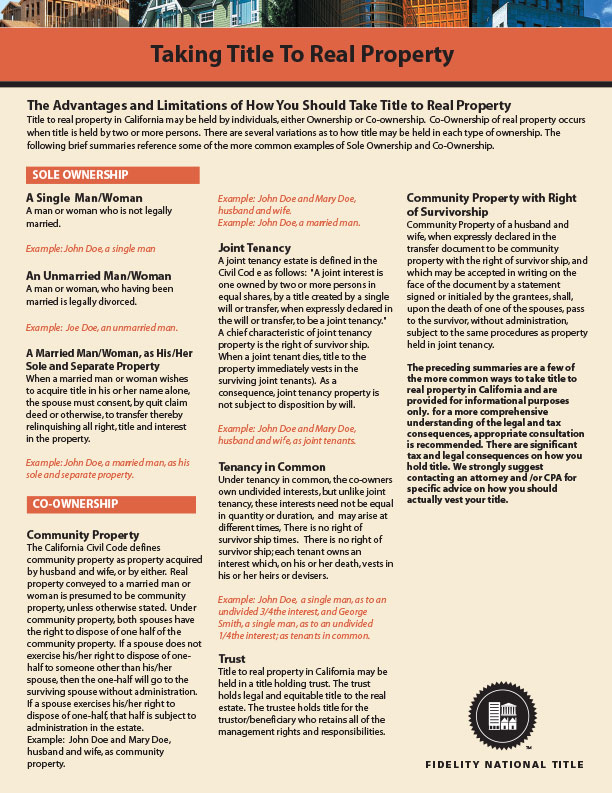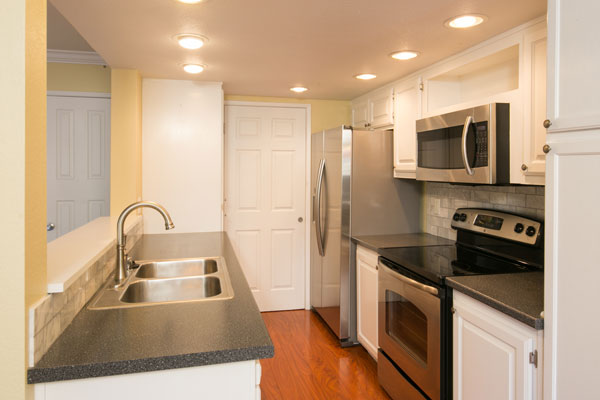To make it easier for you to find and purchase the home of your dreams, John Zeiter of Marin Fine Property has created this informative Marin Home Buyers Guide.
17 Steps to Buying a Home
 Step 1: Find a Realtor
Step 1: Find a Realtor
Searching for a home on your own takes a LOT of time. A Realtor can set you up for automatic search via the MLS (Multiple Listing System), which is a HUGE time saver. If you’re in a hot market, like the San Francisco Bay Area where great properties sell in a matter of days, it can be an enormous advantage to get in and see a property within a day or two of its going on the market. A Realtor can also discover properties before they come on the market.
So, how do you choose a Realtor? You’ll want to find someone who is great at his or her job and someone you like, since you’re going to be spending a lot of time with that person. So, get together and have coffee. Learn about their background and experience. Be certain you “click.”
Step 2: Get Pre-approved for a Mortgage
Getting pre-approved for a mortgage will help you understand how much you can comfortably afford to spend on a home, what your monthly payments will be, what interest rate you qualify for, and how much you’ll be paying each month in taxes, etc. Having a good mortgage lender is a crucial part of ensuring a smooth transaction. I work with several highly skilled mortgage lenders, and I am happy to make a recommendation.
Generally, once you submit the necessary paperwork to your lender, you should receive a pre-approval letter within 2-3 business days. Mortgage lenders are required to provide you with a Good Faith Estimate (GFE) within 3 days of receiving your pre-approval. The GFE provides an estimate of the closing costs you’ll need on top of your down payment and shows exactly what fees the mortgage lender is charging you.
Paperwork You’ll Need To Gather:
- A completed application. The lender will provide this to you directly.
- The two most recent months (or a quarterly statement) of any asset information listed on the application: checking, savings, 401k, mutual funds, individual stock accounts, IRA’s, etc.
- Most recent month of a paystub.
- Past two year’s worth of W2s.
- Past two year’s worth of US Tax Returns or Corporate Tax Returns (if self-employed and you own over 25% of the company).
Then, don’t spend extra money. Your mortgage pre-approval will be granted based on the amount of money you have at the time of the pre-approval in your savings accounts, checking accounts, retirement accounts, etc. and the amount of debt you have (car payments, student loans, your current mortgage, etc). If you buy a TV, a new car, new furniture, etc. between now and closing, it could put your chances of being approved for your mortgage in jeopardy because the lender will pull your credit history one more time the day before closing.
Step 3: Find the Home of Your Dreams
Make a list of your top 4-6 needs and your top 4-6 wants. Your needs are the things you absolutely cannot live without – you won’t even look at a property unless it has every one of them. Your wants are the things you’d really like, but can live without, if needed. Once you have your list, I’ll set you up for auto search on the MLS so that each evening you’ll get an email with all of the new properties that have come on the market that day matching your criteria.
When there’s a home you want to see, shoot me a quick email or phone me letting me know when you’re available so that I can set up a showing. While you’re looking at the MLS feeds each day, I’ll also be networking my contacts to find homes before they go on the market.
IDX Image
Click here to download a PDF with more information about buying a home in California.
 Step 4: Let’s See Some Homes!
Step 4: Let’s See Some Homes!
Sellers usually require 24 hours notice prior to showings. They may also put other limitations on showings, such as no showings after 6pm or on Sundays. Some sellers will have Nanny Cams in their homes so be aware of what you say and do. Don’t talk about how much you can afford, what kind of offer you want to make on the home, etc. while in the house in case someone is listening. If sellers are home, be careful not to give too much away about yourself and why you’re buying, since that information could hurt us later during the negotiation process.
Step 5: Make An Offer
You’ve found the perfect home and want to put in an offer – in today’s market we need to put your offer in ASAP, ideally within a few hours. We’ll firm up:
- Your offer price: What price you want to offer for the home. The sale-to-list price in the neighborhood will tell us a lot about whether you should expect to pay below asking price, asking price, or above asking price.
- Your walk away price: Don’t expect to pay your initial offer price, since it’s rare for a seller to accept your initial offer without some negotiating back and forth. It’s always best to decide what your walk away price is before negotiations start.
- We will also want to establish your earnest money amount, down payment, whether or not you want closing cost credits, whether you want to ask the seller to provide a home warranty on the property and any contingencies.
Step 6: Contract Acceptance
Often contracts are accepted verbally by the seller’s agent, while signatures are gathered from the sellers. It can take 1 – 2 days for all parties to sign and return the contract. Until we have an executed contract (which means everything has been signed by both the sellers and the buyers), we do not have an enforceable one. Once a signed contract is received, several things need to happen:
- The contract needs to be sent to your mortgage lender.
- You need to schedule a home inspection.
- You need to write the first earnest money check.
Step 7: Home Inspection
It’s important that the home inspection occur as quickly as possible because it often takes the inspector 1-2 days to write the report after the inspection. Legally, I am not allowed to schedule the home inspection, but I can recommend a competent home inspector if you don’t already have someone in mind.
Attending the home inspection is one of the most important parts of buying a home, since you’ll want to make sure the property you’re buying is in good shape. You’ll get a written report after the inspection, but it doesn’t give you nearly as clear of a picture of the condition of the house as being there first-hand and asking the inspector questions. Unless you’re extremely knowledgeable about home construction, it’s difficult to understand what is in the inspection report. It’s crucial you understand each issue and whether it’s minor or an expensive repair.
If you are planning to have any work done to the home, it’s best to arrange for contractors, painters, floor refinishers, etc. to come by sometime during the inspection to offer estimates, since we may not be able to get into the home again until the final walk through.
Once the inspection report comes back, review it thoroughly. Don’t be surprised if it’s 30 + pages long with more than 25 “issues” that should be repaired. If there are any “big-ticket” items, decide if you want to have additional inspections performed. For instance, we can bring in a structural engineer, a sewer inspector, an electrician, a pest inspector, etc. If you want to bring in additional inspectors, you’ll be responsible for paying their fees. Keep in mind that you can ask the sellers to repair items or provide a credit to fix items after closing. Credits go towards your closing costs.
Step 8: Schedule The Closing On Your Calendar
On average, closing takes about 2 hours, but if there is a problem it could take up to 4 hours. The closing location and exact start time won’t be scheduled until your mortgage officer gives us a Clear to Close (CTC), which generally occurs 2 days to one week prior to your closing date.
The day prior to closing, you will need to wire transfer your down payment and closing costs to the title company. If you are planning to move into your new home on the day of closing, schedule the move for at least 1 – 2 hours after closing ends, if possible. Legally you can’t move into the house until the end of closing, once the bank funds the loan and transfers the funds to the seller.
 9: Review the Condo Documents
9: Review the Condo Documents
If you’re buying a condo, you need to review and approve or disapprove the condominium documents. These documents generally include the Declarations and Bylaws, the Rules and Regulations, the current year budget, the meeting minutes, and the 22.1 disclosure. You need to figure out if the building is stable and healthy, financially speaking, or if there could be potential problems, such as big upcoming maintenance issues or delinquent condo owners who aren’t paying their HOA fees. I strongly urge you to read every condo document thoroughly. Write down any questions or issues you’d like to know more about, and we can ask for clarification or further documentation. Pay particular attention to the meeting minutes, since this is often where you’ll learn what’s really going on in the building and any future plans for big-ticket repairs.
Step 10: Write the Second Earnest Money Check
Once we’ve come to an agreement on the inspection items and you’ve approved the condo documents, you’ll need to write the second earnest money check. The second earnest money check is usually 2% – 5% of the purchase price, but it can be up to 10% of the purchase price.
Step 11: The Appraisal
Your mortgage lender is the person who orders the appraisal, and the appraisal process and report will generally take 2 weeks. Once the report is written, it’s given to your mortgage lender. Your mortgage lender will then forward it to you and let you know whether the property appraised at the purchase price, below the purchase price, or above the purchase price. If the property appraised at or more than the purchase price, nothing further needs to be done, and the closing process will proceed forward as planned.
If the property appraised for less than the purchase price, the bank will only give you a loan for the appraised value. In this case, we can go back and renegotiate the purchase price down with the sellers, ideally to the appraisal price. If they won’t come down to the appraisal price, you can choose to either walk away and get your earnest money back or bring the additional funds to closing.
Step 12: Purchase Homeowner’s Insurance
One of the things the mortgage underwriter will require you do during the underwriting process is to set up homeowner’s insurance. You want to make sure your new home is properly insured. My advice is to shop your homeowner’s insurance around because rates can vary dramatically and start with whatever company insures your car, since you’ll probably get a discount.
Have your homeowner’s insurance policy go into effect the day BEFORE you close on your new home. That way if your new home should be damaged while you’re at closing, you’ll be covered. Also, be sure to get proper documentation from your new homeowner’s insurance company to your mortgage underwriter. They will require proof of insurance before they’ll approve your loan.
Step 13: Get Your Down Payment and Closing Costs Ready
In addition to the down payment, you’ll need approximately 3% of the purchase price available in cash for closing costs. It’s best if the down payment and closing cost funds are transferred into one account. This account must be disclosed to your mortgage lender, since the funds have to be tracked.
One business day before your closing date, your mortgage lender will email you an estimate of the amount of money needed to close as well as the wire transfer instructions. Amounts under $50,000 can be paid for with a cashier’s check, however, amounts over $50,000 must be wire transferred. You’ll wire transfer these funds in one lump payment the DAY BEFORE CLOSING, since the Title company cannot accept payment the day of closing. You’ll want to call your bank ahead of time and find out what you need to do to make a wire transfer. Most of the time you have to go into the bank personally to initiate the wire transfer. Also, find out their cut off time for wire transfers – usually it’s around 4pm.
Step 14: Clear to Close
Clear to Close means that the lenders and underwriters have looked at all of the paperwork, your bank accounts, etc. and have approved the loan. By giving us the Clear to Close, they are saying we can move forward with the closing and that they will fund the purchase of your new home. I’ll schedule the final walk through, which is usually conducted the day before closing.
Step 15: The Walk Through
Once you’ve received the Clear to Close, we’ll schedule the final walk through. This is a chance for you to make sure everything in your new home is in working order. The seller’s Realtor usually attends the walkthrough in case any problems come up.
Here’s what you should check at the final walk through:
- All repairs have been made – obtain copies of paid receipts and any related warranties in advance of the walk through.
- All of the appliances are still working.
- That the sellers didn’t damage anything while moving out.
- All items included in the sales price (lighting fixtures, blinds, curtains, etc.) are still there.
- Screens and storm windows are in place or stored somewhere.
- Test the intercom, doorbell, alarm, HVAC and hot water to make sure they all work.
- Property should be in “broom clean” condition, meaning it doesn’t have to be perfectly clean, but you have to be able to clear out any debris with a broom.
- Get the garage door opener (if applicable) and any other remotes.
- Locate any instruction books and warranties for appliances and fixtures.
Step 16: Attend the Closing
Closing will not be set until the buyer’s lender issues a clear to close (CTC) loan approval. Closing takes approximately 2 hours, however, it can take up to 4 hours if there are problems.
A few important reminders for closing:
- Bring your photo ID with you (ideally a driver’s license or passport).
- Bring your checkbook (just in case).
- Bring copies of your earnest money receipts and wire transfer receipt for the deposit and closing costs.
At the very end of the closing, the Title Officer will give you an overage check, which is essentially a refund of any additional money you transferred over when you sent your down payment and closing cost fees. You’ll also receive a copy of the HUD/Settlement statement. You’ll need it next year when you prepare your taxes. Last, but not least, you’ll get your keys and can now officially move in!
Step 17: Staying in Touch with Your Realtor
Your Realtor is an incredible resource for you as a new homeowner because they can answer questions, provide referrals to help maintain your home, and check in on its value, should you be interested in selling. You’ve built a strong relationship with you Realtor – don’t let it disappear.
Congratulations, new homeowner!








